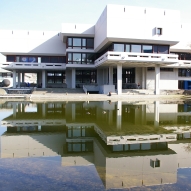| PDF (2MB) - Nur für Mitarbeiter des Archivs |
- DOI zum Zitieren dieses Dokuments:
- 10.5283/epub.57
Zusammenfassung
Divinylphenylene bridged diruthenium complexes E,E-[{(PiPr3)2(CO)ClRu}2(µ-HC=CH-C6H4-CH=CH-1,3)] (m-2) and E,E-[{(PiPr3)2(CO)ClRu}2(µ-HC=CH-C6H4-CH=CH-1,4)] (p- 2) have been prepared and compared to their PPh3 containing analogues m-1 and p-1. The higher electron density at the metal atoms increases the contribution of the metal end groups to the bridge-dominated occupied frontier orbitals and ...

Nur für Besitzer und Autoren: Kontrollseite des Eintrags



 Downloadstatistik
Downloadstatistik